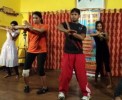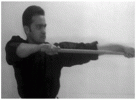Wing Chun General Course

by India Wing Chun Academy (IWCA)Mumbai |
Request Info |
Category: Self Defense & Martial Arts
| Medium of instruction: | English |
This is the general module which we recommend for the general public. 3 sessions / fortnight, each session of 2 hours. The students are given drills and exercises which must be incorporated in the daily routine for authentic and steady development in wing chun. The class will cover concepts and drills which need to be understood and implemented in day to day practice. We also cater to the individual student queries and recommendations for quick progress. There will be quarterly / module wise exams to check the progress and only after passing these will the student be allowed for the next stage.
Curriculum: General course has 6 modules and certification is given per module post clearing the exam.
1. Basic skills and conditioning – 4 to 6 months
2. Siu Lim Tau form and application – 4 to 6 months
3. Chum Kiu form and application – 4 to 6 months
4. Biu Tze form and application – 4 to 6 months
5. Wooden Dummy form and application – 4 to 6 months
6. Weapons : Butterfly Sword & Long Pole – 4 to 6 months
Wing Chun Forms
Siu Nim Tao : The Little Idea Form ”Sifu Sergio’s DVD on Siu Nim Tao”
Siu Nim Tao also called “The Little Idea Form” is the First and the foundation building form which an individual's beginning Wing Chun skills are developed. This first form is a stationery form and contains many of the hand motions found in the Wing Chun system. All movements are executed from the training stance, with no turning of the waist. In this way, the student learns to maintain relaxation, and execute quick, springy punches. In the advanced stages Siu Nim Tau reveals the chi-kung aspects of Wing Chun. Siu Nim Tau has 108 motions organized logically in 3 sections or sets. These motions can give rise to unlimited combinations of simultaneous attack and defense.
Chum Kiu : Searching the Bridge Form
Chum means “to search” or “to sink”, Kiu means “bridge” hence Chum Kiu means, "searching for the bridge" or "sinking the bridge" is the second form of Wing Chun. When one of your arms makes contact with the arm of an opponent a bridge is created. Chum Kiu is a dynamic form; here the student is formally introduced to the concept of stance turning, kicking and a variety of combination trapping hand exercises. He or she is also instructed in greater detail about the Centerline Theory as pertains to the Horizontal Centerline.
BiuTze : Darting Fingers Form Sifu
The Biu-Tze the “Thrusting Fingers” or the “Darting Fingers” form is final and an advanced empty hand form of Wing Chun. In the past, there was a saying that "the Biu-Tze form was not to be passed to persons outside the family door. " That is to say, no one was to be taught this form, unless they were chosen disciples.
The logical reason was it was only taught on a one to one basis and a student must certainly have absorbed all the concepts from Siu Lim Tao and Chum Kiu. Consisting of 12 sections the form can be interpreted as an attacking form and certainly contains many sophisticated ideas. The emphasis on energy is put in the elbows, fingertips and hand. Suffice to say that Bui Tze covers extremely close range combat techniques which take the Wing Chun practitioner on the next paradigm of mastery.
The Bui Tze hand contains emergency techniques. The iron fingers can strike a vital point at once. Wing Chun Kuen Kuit on Bui Tze
Mook Yan Jong :The Wooden Dummy Form
The 116 Wooden Dummy Techniques are the most superior techniques of Wing Chun kung fu. Knowledge of the secrets of the application of these techniques will enable a contestant to react much more swiftly than his fellow student who applies only the fundamental techniques of the other forms. Consisting of 8 sections, the techniques here exSemplify 3 attacks simultaneously. Due to the perfect angle of the Wooden Dummy’s structure even the slightest error in one’s own structure tends to be magnified and can therefore be immediately recognized and corrected. Besides this the wooden dummy is an untiring partner for serious Wing Chun practitioner and trains the “Sticking to the Opponent Skill”.
The wooden man develops the use of power. Adhesion power when achieved will be a threatening force. Wing Chun Kuen Kuit on Mook Yan Jong
The weapons are the last units in the Wing Chun system and are only taught after the three empty hand forms and the wooden dummy are completely mastered.
Luk Dim Boon Kwun : Six and A Half Point Pole Form
The first of the Weapon Sets, Luk Dim Boon Kwun, literally translates as Six-and-a-half-point-long Pole. This form is believed to have been introduced around the time of the Red Junk opera troop. It is a short form and introduces the basic parries and attacks; there are only six and half techniques, hence the name. The pole form develops great strength in the wrists and stance. The Luk Dim Boon is simple, direct and deadly.
Bart Chum Dao : Double Butterfly Knives Form
After working towards mastery of the pole skills the final stage of advanced Wing Chun skills is introduced through the Bart hum Dao form. The Bart Chum Dao is also known as the Butterfly Knives Form because of the appearance of the blades when crossed. The form is in eight sections demonstrating the various defensive and attacking maneuvers. The knives are used as an extension of the hand shapes and many of the common techniques can be performed with knives. Hidden in the form are advanced stepping techniques accompanied by the attack and defense motions. The form can also be performed with two rattan sticks.
| Classroom - Regular | ||||
| When | Duration | Where | Remarks | Price |
| Not Specified |
3 Years 3 Sessions |
All Venues | Each session of 2 hours | Price On Request |
Mumbai, Borivali East (Center):- Western Railway Social Welfare Center, Railway Colony Borivali East, Mumbai - 400066, Maharashtra, India
India Wing Chun Academy (IWCA)
INDIA WING CHUN ACADEMY (IWCA), the Invented by a woman Wing Chun Kung fu is the one of the most widely practiced Chinese kung fu styles in the world. Wing Chun relies on skill and fighting concepts which allows a weaker and smaller person to successfully defend against a bigger and stronger opponent. Hence it is best for women and small frame individuals.
At the IWCA, we pledge to pass on the same authentic knowledge of Wing Chun to you.
Launched on 5th May 2010 in Mumbai, IWCA headquarters has successfully trained young and old, male and female alike. IWCA believes in teaching quality Wing Chun to quality people, hence we follow the traditional Wing Chun approach of imparting strong basic principles balanced with personal, customized training. We have developed an immensely practical but injury-free approach to learning and applying Wing Chun for self-development and self-protection.
Our Motto: Quality Wing Chun to Quality People.
Our Goal: To help you become a healthier, fit and confident individual with at least a basic mastery of Wing Chun. How far you go depends on your personal level of commitment and dedicated practice!
Our Vision: To provide the most authentic, world class Wing Chun knowledge by creating role-model IWCA instructors in all major Indian cities by 2015.
Our Promise: To provide you with both high quality theoretical knowledge and the practical fighting skills of Wing Chun.
For those who aspire to learn Wing Chun, this is an excellent opportunity. If you have never practiced any martial arts before, the IWCA can be your starting step. If you are already an established practitioner of Wing Chun or any other martial art, we invite you to join us in our journey on the Tao of Wing Chun.
Team "India Wing Chun Academy (IWCA)"
India, Mumbai











